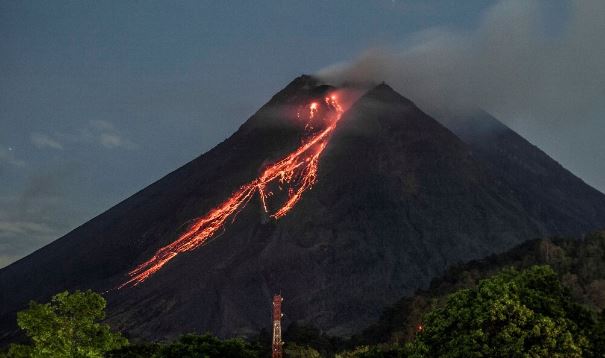Devastation in West Sumatra: Marapi Volcano’s Deadly Eruption

Indonesia’s Marapi volcano, located in West Sumatra, erupted violently on Sunday, spewing ash as high as 3 kilometers (approximately 9,800 feet) into the sky. This catastrophic natural event has led to significant loss of life and ongoing search and rescue operations. As of Monday, eleven climbers have been confirmed dead, and twelve others remain missing. The eruption has caused widespread panic and devastation, underscoring the volatile nature of the region’s geology.
The Marapi volcano, standing at 2,891 meters (about 9,485 feet) tall, is one of the most active volcanoes on Sumatra island. Its most deadly eruption occurred in April 1979, claiming 60 lives. This year, the volcano had shown signs of activity between January and February, with ash spewing around 75 to 1,000 meters from the peak. The Indonesian authorities have raised the alert to the second-highest level and have prohibited residents from venturing within 3 kilometers of the crater.
Following the eruption, the search for the missing climbers was temporarily halted due to safety concerns after a smaller eruption occurred on Monday morning, spewing volcanic ash around 800 meters high. Video footage captured the dramatic scenes of a vast cloud of volcanic ash spreading across the sky, covering cars and roads with ash. These incidents highlight the ongoing risks posed by the volcano to the local community and visitors.
Rescue operations have been challenging, with Jodi Haryawan, a spokesperson for the search and rescue team, noting the difficulty in evacuating bodies from the volcano. It reportedly takes around four to six hours to evacuate one body. In total, 49 climbers were evacuated from the area earlier on Monday, many of whom were being treated for burns. The rescue teams have continued their efforts to search for the missing climbers and evacuate the three survivors and bodies of the deceased climbers.
Indonesia is situated on the Pacific’s “Ring of Fire,” a region known for its seismic activity, including earthquakes and volcanic eruptions. The country has 127 active volcanoes, making it one of the most geologically active regions in the world. The Marapi volcano’s eruption is a stark reminder of the natural hazards that the Indonesian archipelago faces due to its location on this volatile seismic belt.
This tragic event in West Sumatra brings to the forefront the unpredictable and often devastating power of nature. The loss of life and the ongoing search and rescue operations serve as a poignant reminder of the importance of disaster preparedness and response in such high-risk areas. As Indonesia continues to grapple with the aftermath of the Marapi volcano’s eruption, the international community watches closely, extending support and solidarity to those affected by this natural disaster.





